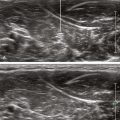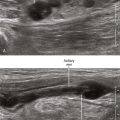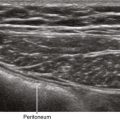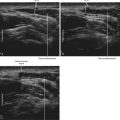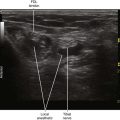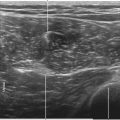Appendix 1 Self-Assessment Questions: Text
1. Why do peripheral nerves often appear more echogenic after injection of anechoic local anesthetic?
2. Which of the following statements regarding peripheral nerve anatomy is most correct?
3. Which of the following is most accurate?
4. Which of the following statements regarding probe compression is most correct?
5. What term describes the fact that the received echoes from peripheral nerves vary with the angle of insonation?
6. Which of the following statements is most accurate?
7. Which of the following influences needle tip visibility? (Select all that apply.)
8. Which of the following is associated with comet-tail artifact?
10. Which of the following statements regarding interscalene block is true?
11. Which of the following statements regarding the first rib and pleura is true?
12. What is the most common anatomic variation in the interscalene region?
13. The phrenic nerve lies on which muscle in the neck?
14. The cords of the brachial plexus are named with respect to what structure?
15. What branches leave the brachial plexus sheath under the pectoralis minor at the coracoid process?
16. At the level of an axillary block, the musculocutaneous nerve typically lies in what muscle?
17. Regarding the anatomy of the axilla, pick one nerve (MCN, RAD, MED, ULN) for each:
18. True or False? In most subjects, the lateral femoral cutaneous nerve travels over (superficial to) the sartorius muscle near its insertion on the anterior superior iliac spine.
19. Which of the following statements regarding the femoral nerve are true? (Select all that apply.)
20. The femoral nerve lies deep to which of the following structure(s)? (Select all that apply.)
21. True or False? The saphenous nerve travels with the infrapatellar nerve and the nerve to the vastus medialis throughout most of its course in the thigh.
22. The saphenous nerve follows the course of what major structure as it descends the medial leg?
23. Which muscle separates the anterior and posterior divisions of the obturator nerve?
24. Which adductor muscles are not innervated by the obturator nerve?
25. Name the blood vessel most closely associated with the following nerves:
REFERENCES: Sunderland S. The connective tissues of peripheral nerves. Brain 1965;88:841–54.
Sunderland S, Bradley KC. The perineurium of peripheral nerves. Anat Rec 1952;113:125–41.
The nerve that passes though the coracobrachialis muscle: MCN
The nerve that passes between the axillary artery and vein: ULN
The nerve that follows the profunda brachii artery into the triceps: RAD
The nerve that passes from lateral to medial over the surface of the axillary artery and can be displaced to either side of the artery with probe compression: MED
Saphenous nerve—saphenous vein
Tibial nerve—posterior tibial artery
Sural nerve—small saphenous vein
Superficial peroneal nerve—no major vessel is commonly associated (a small fibular artery is sometimes present)
Deep peroneal nerve—anterior tibial artery and dorsalis pedis artery
CLINICAL SIGNIFICANCE: Vascular landmarks often help identify peripheral nerves.

